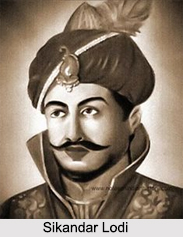 Sikandar Shah Lodi proved himself an able and competent ruler and achieved success in extending his empire and restoring the prestige of the Sultans. Sikandar Lodi suppressed those opponents who could dispute his succession. He destroyed the powers of the nobility, finished all rebellious nobles and forced others to respect and obey him as a Sultan. He is rightly claimed to be the greatest Lodi Sultan.
Sikandar Shah Lodi proved himself an able and competent ruler and achieved success in extending his empire and restoring the prestige of the Sultans. Sikandar Lodi suppressed those opponents who could dispute his succession. He destroyed the powers of the nobility, finished all rebellious nobles and forced others to respect and obey him as a Sultan. He is rightly claimed to be the greatest Lodi Sultan.
The rebellions of jagirdars of Jaunpur gave an opportunity to Sikandar Shah Lodi to conquer Bihar. He attacked Tirhut from Bihar. The Rai of Tirhut accepted his supremacy without fighting. Sikandar Lodi also succeeded partially against the Rajput state. He conquered Dholpur, Mandrail, Utgir, Narwar and Nagaur. He defeated the ruler of Gwalior occasionally but failed to annex Gwalior in his territory. He founded the city of Agra in 1504 A.D. to keep control over the Rajput rulers. The conquest of Bihar was a remarkable success of Sikandar Lodi in extending of his imperial territory. He kept Jaunpur under his control and raised his prestige among the Rajput chiefs by defeating some among them.
Sikandar Lodi was well aware of the limitations of his resources and tried to maintain peaceful relations with other Muslim kingdoms. He tried his best to deal with the rebellious and independent nature of his own Afghan nobles. He started sitting on the throne and compelled his nobles to show formal respect to him in the court and even outside. He framed certain rules which were observed by all the nobles and governors to honour the Sultan. Sikandar made no distinction between the rich and the poor while dispensing justice. He organised an efficient espionage system which helped him to keep the nobles under control. All these measures succeeded and Sikandar Lodi was successful in controlling tendencies of tribal independence of his nobles. However, he was not tyrant or disrespectful in his treatment towards his nobles. His sole motive was to restore the prestige of the sultan and he succeeded in that.
Sikandar Lodi was a laborious, generous and just ruler. He worked hard to carry a good administration. He dispensed impartial justice to all his subjects and encouraged trade and agriculture. He abolished all internal trade duties. He was successful in maintaining peace and order within his kingdom. All these enhanced the economic prosperity of the state. The reign of Sikandar Lodi was that of peace, order, prosperity and progress.



















